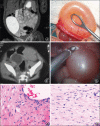Management of ovarian cysts in infants
- PMID: 26958055
- PMCID: PMC4766827
- DOI: 10.4103/1735-1995.172988
Management of ovarian cysts in infants
Abstract
Background: To discuss the experience of diagnosis and treatment of ovarian cyst in infants.
Materials and methods: A retrospective review was conducted on 20 infants who suffered from ovarian cyst.
Results: There were no dysplasia ovarian was found in children which were preoperatively diagnosed simplex cyst. Within thirteen children preoperatively detected mixed cystic-solid lesion, six cases ovarian cysts disappeared and two cases underwent poor blood supply in the following time.
Conclusion: Adverse effects for ovarian cyst in infants can be prevented by agressive surgical intervention. Harmful effects of ovarian cyst can be prevented by positive surgical intervention despite the diagnostic difficulties in children with clinical symptoms of this condition.
Keywords: Infants; laparoscopic; ovarian cyst.
Figures



Similar articles
-
"Daughter cyst" sign: a sonographic finding of ovarian cyst in neonates, infants, and young children.AJR Am J Roentgenol. 2000 Apr;174(4):1013-5. doi: 10.2214/ajr.174.4.1741013. AJR Am J Roentgenol. 2000. PMID: 10749241
-
Laparoscopic diagnosis and management of ovarian torsion in the newborn.JSLS. 1999 Apr-Jun;3(2):141-3. JSLS. 1999. PMID: 10444015 Free PMC article.
-
[Antenatal diagnosis and postnatal management of ovarian cysts].Ann Acad Med Stetin. 2006;52(2):45-9. Ann Acad Med Stetin. 2006. PMID: 17633396 Polish.
-
Ultrasound diagnosis and evaluation of fetal tumors.J Perinat Med. 1989;17(3):173-93. doi: 10.1515/jpme.1989.17.3.173. J Perinat Med. 1989. PMID: 2681672 Review.
-
Current diagnosis and management of ovarian cysts.Clin Exp Obstet Gynecol. 2014;41(6):609-12. Clin Exp Obstet Gynecol. 2014. PMID: 25551948 Review.
References
-
- Cuizhu F, Jidong M, Ying W, Lishuang M, Yue Z, Qinqin Y. Prenatally diagnosis, systematic management and early surgical treatment of neonatal ovarian cysts. Chin J Neonatol. 2013;28:238–40.
-
- Song G, Qimin C, Min X, Zhilong Y, Li H, Jun CA, et al. Torsion of ovarian cysts in neonates. Chin J Pediatr Surg. 2008;29:65–6.
-
- Grumbach MM, Kaplan SL. Fetal pituitary hormones and the maturation of central nervous system of anterior pituitary function. In: Gluck L, editor. Modern Perinatal Medicine. Chicago: Medical Publishers Year Book; 1975. pp. 247–56.
-
- Richardson GS. Hormonal physiology of the ovary. In: Gold JJ, Josimovich JR, editors. Gynecologic Endocrinology. New York: Harper & Row; 1980. pp. 123–46.
-
- Giacoia GP, Wood BP. Ovarian cyst of the newborn. Am J Dis Child. 1987;141:1005–6. - PubMed
LinkOut - more resources
Full Text Sources
Other Literature Sources

